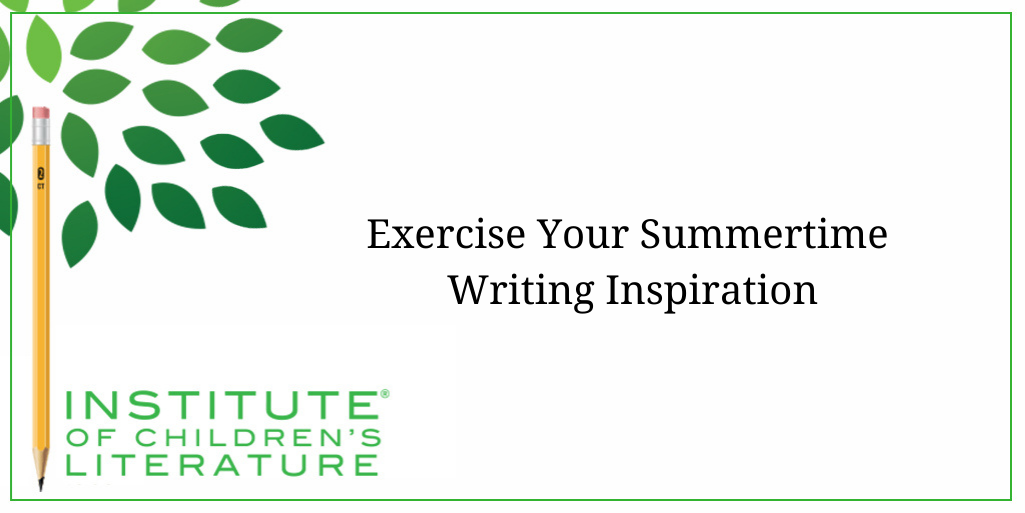
5 Ways Writers Can Prep for 2025 Goal Setting
Before we roll on to the new writing year, let’s harness our optimism for the blank slate before us and prepare for our 2025 Goal Setting just for writers.

Summer can offer writers new opportunities due to the change of schedule that often comes with this time of year. This is true for adults and young people alike with schools on break and more time spent outside. All these changes can come with unique writing inspiration, but it can be tempting to put your writing on the back burner with all the demands of summer schedules.

Summer tends to take people outside with everything from summer social gatherings to gardening to simple walks. With this in mind, it’s a great time to stretch your creative muscles by imagining new settings and new places. One great writing exercise involves doing an online image search for “summer garden” or “vacation spot” or maybe “exotic locale.” The images that come up in searches like this let us imagine ourselves in new places. Think about someone who might live in this location or who may be visiting it. Then let yourself visualize being that person, moving through this environment. Did your inspiration picture have comfy garden furniture? Imagine sitting down. How does it feel? What do you see from this new angle and perspective? With so much life in bloom, what scents are carried to you on the summer breeze? What do you hear?
Maybe your search took you to a very different place like a seaside villa with paths weaving between swaying palm trees, or an unusual boardwalk carrying you high above bamboo forests. Whatever photo captures your imagination, let your mind take you beyond the detail you see and imagine more sensory detail. What does that white sand feel like under your feet? What’s it like clambering into that hammock strung up between two trees and overlooking a crystal cove? What sounds do you hear? What do you smell? Is it hot or warm? Is there a breeze? Spend a while really imagining yourself deeply in this location. This kind of writing exercise not only lets you stretch your writing muscles, but it’s relaxing as well, letting your imagination take you on your own mini vacation.
Many of us regularly need to practice our description skills. Sure, we’re no longer in a literary period where you can spend pages and pages describing clouds and know the reader will stick with you through it, but description continues to be important. As we describe a character interacting with objects in the environment, we believe more in the story and we get to know the character a little bit better.

One excellent writing exercise (which can be done even when you’re experiencing the depths of writer’s block) is describing a single object. You can choose nearly anything. From where I sit right now in my office I could choose my cardigan, set aside in a crumpled heap because my office isn’t quite cool enough for it. I could choose the wooden box that holds my meds (kept next to my desk in the hope I’ll remember to take them daily). I could choose the Eeyore snow globe, a past Christmas gift. I could choose something from my tea can filled with pens or I could choose the can itself.
There are always options at hand. If I was writing outside, I could choose a stone or a leaf or a really good stick. And then I could begin to experience it and write down all the elements of my description. What does it look like, really look like? A really good stick, for example, doesn’t just look like a stick. That’s a lazy description. A really good stick bears the scars of all the tiny branches that it tried to grow along its length, the ones that are no longer there. It never really loses the mark of that effort. A really good stick is more than one color. It’s the color of bark, sure. But it’s also the color of the broken end that had been hidden from view until the stick was snapped off its tree. It may be the color of lichen in spots. A really good stick isn’t just straight, even an excellent straight stick isn’t truly straight. Nature so rarely allows straight lines because every trip worth taking has a detour or two, and that was true of the growth of the really good stick as well. Does the really good stick have a smell? What is its texture?
While you’re experiencing your object, go beyond the surface and let associations bubble up. Let the stick remind you of being a child when a really good stick was an excellent toy for all sorts of things, for poking and swatting and fighting duels in the summer sunshine. A good description session should run on for at least a page in your exercise journal, so if you feel like you’re running out of things to say before you run out of page, go in a different direction. Imagine the object as discovered by an alien or an archeologist centuries in the future. Imagine something the object might be used for that isn’t obvious (shoved into a closing elevator door, thrown to distract a killer tracking you, used to kill someone?) There’s more there than you think, just keep thinking.
One of the most delightful tools in a writer’s kit is comparisons. Comparisons come in many forms: the simile (and it’s more sober, literary big brother, the metaphor), the analogy, and even the allusion exist primarily to bring something to a moment that goes beyond the obvious and offers either a little emotional goose to the moment or an extra dash of clarity. As a result, practicing your comparison skills will make you a better writer.
Pick up any object and begin to ponder what it is like. A grapefruit, for example, is very much like a softball, but what else is it like? Well, if you break through its skin, it will spit at you, juice that most certainly ends up in your eyes, making them sting. And that always reminds me of a cobra spitting to blind its prey. Is the grapefruit about to attack? Maybe. It’s a weird comparison but that’s the beauty of this exercise, you have the luxury to get weird because it’s simply an exercise. Your comparison doesn’t have to make sense to anyone else. It’s just yours. A summer sidewalk is a griddle for bare feet. A capybara is a child’s drawing of a horse come to life, all rectangles and stick legs. A lemon snow cone is a mouthful of winter sun. So, what can you come up with? What do the common objects you encounter every day remind you of when you really see them and go beyond what they are and think about what they are like?
Sometimes having to come up with a story when you’re only looking at a blank screen is much harder than coming up with a new idea based on a prompt. One way I sometimes do this is by looking at Calls for Submission. For instance, the blog Publishing…and Other Forms of Insanity publishes a fresh “Calls for Submission” post every month and these make wonderful story prompts.

As ideas pop into my mind, I jot them down (doesn’t matter how silly, because sometimes the silliest ones come back again and again until they become a real story). Usually, I’m only writing a sentence or two for each one, but I write as long as I feel the excitement or interest. It might be a sentence, a paragraph, or a page. It might even turn into an actual story right there. You never know. It’s one of the things that make this exercise so exciting. I never know what submissions call might prompt a story that clicks.
So now you have four great writing inspiration exercises for your summer exercise notebook. Give one a try and see what you can come up with. With exercises, you can’t fail. No matter what you do with them, you’ve done right. So have fun with them, explore, play, be silly or serious, whatever works for you. You’re going to be surprised by what you come up with as you scribble in this journal. I’ve written whole books inspired by one line, one comparison, one thought from one exercise. There will be gold in there when you’re done. Gold, and a whole lot of fun. Give it a try. You know you want to.
With over 100 books in publication, Jan Fields writes both chapter books for children and mystery novels for adults. She’s also known for a variety of experiences teaching writing, from one session SCBWI events to lengthier Highlights Foundation workshops to these blog posts for the Institute of Children’s Literature. As a former ICL instructor, Jan enjoys equipping writers for success in whatever way she can.

Before we roll on to the new writing year, let’s harness our optimism for the blank slate before us and prepare for our 2025 Goal Setting just for writers.

Writers can be thin-skinned when it comes to getting feedback on their work. Let’s look at 4 ways to positively deal with constructive criticism!

Rejection is part of the territory when it comes to being a writer. Today we offer reflection for writers to help redirect your efforts after a rejection.
1000 N. West Street #1200, Wilmington, DE 19801
© 2024 Direct Learning Systems, Inc. All rights reserved.
1000 N. West Street #1200, Wilmington, DE 19801
© 2024 Direct Learning Systems, Inc. All rights reserved.
1000 N. West Street #1200, Wilmington, DE 19801
© 2024 Direct Learning Systems, Inc. All rights reserved.
1000 N. West Street #1200, Wilmington, DE 19801
© 2025 Direct Learning Systems, Inc. All rights reserved.
1000 N. West Street #1200, Wilmington, DE 19801
©2025 Direct Learning Systems, Inc. All rights reserved. Privacy Policy.
4 Comments